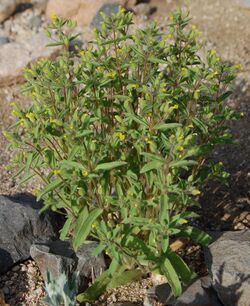Biology:Mimetanthe
| Mimetanthe | |
|---|---|

| |
| Scientific classification Error creating thumbnail: Unable to save thumbnail to destination
| |
| Kingdom: | Plantae |
| Clade: | Tracheophytes |
| Clade: | Angiosperms |
| Clade: | Eudicots |
| Clade: | Asterids |
| Order: | Lamiales |
| Family: | Phrymaceae |
| Genus: | Mimetanthe Greene |
| Species: | M. pilosa
|
| Binomial name | |
| Mimetanthe pilosa (Benth.) Greene
| |
| Synonyms[1] | |
| |
Mimetanthe is a genus of flowering plants in the family Phrymaceae. It has only one species, Mimetanthe pilosa, synonym Mimulus pilosus,[1] known by the common names false monkeyflower[2] and downy mimetanthe. It is native to the western United States (Arizona, California, Idaho, Nevada, Oregon, Utah and Washington State) and Baja California, where it grows in moist and disturbed habitat types. This plant is different enough from other monkeyflowers that it is treated in its own monotypic genus, Mimetanthe, or it may be retained in Mimulus.[1][3][4][5][6][7]
It is an annual herb growing to a maximum height of about 35 centimeters. It is coated densely in long hairs. The oppositely arranged, narrow or wide lance-shaped leaves 1 to 3 centimeters long. The tubular base of the flower is encapsulated in a calyx of sepals. The yellow flower corolla is under a centimeter long, divided into five rounded lobes at the mouth, and often dotted with red in the throat.
References
- ↑ 1.0 1.1 1.2 "Mimetanthe pilosa (Benth.) Greene". Plants of the World Online. Royal Botanic Gardens, Kew. https://powo.science.kew.org/taxon/urn:lsid:ipni.org:names:805852-1.
- ↑ "Mimetanthe pilosa". Natural Resources Conservation Service PLANTS Database. USDA. https://plants.usda.gov/core/profile?symbol=MIPI5. Retrieved 9 July 2015.
- ↑ Beardsley, P. M. (2004). "Patterns of evolution in western North American Mimulus (Phrymaceae)". American Journal of Botany 91 (3): 474–89. doi:10.3732/ajb.91.3.474. PMID 21653403.
- ↑ Barker, W.R.; Nesom, G.L.; Beardsley, P.M.; Fraga, N.S. (2012), "A taxonomic conspectus of Phrymaceae: A narrowed circumscriptions for Mimulus, new and resurrected genera, and new names and combinations", Phytoneuron 2012–39: 1–60, http://www.phytoneuron.net/PhytoN-Phrymaceae.pdf
- ↑ Beardsley, P. M.; Yen, Alan; Olmstead, R. G. (2003). "AFLP Phylogeny of Mimulus Section Erythranthe and the Evolution of Hummingbird Pollination". Evolution 57 (6): 1397–1410. doi:10.1554/02-086. PMID 12894947.
- ↑ Beardsley, P. M.; Olmstead, R. G. (2002). "Redefining Phrymaceae: the placement of Mimulus, tribe Mimuleae, and Phryma". American Journal of Botany 89 (7): 1093–1102. doi:10.3732/ajb.89.7.1093. PMID 21665709.
- ↑ Beardsley, P. M.; Schoenig, Steve E.; Whittall, Justen B.; Olmstead, Richard G. (2004). "Patterns of Evolution in Western North American Mimulus (Phrymaceae)". American Journal of Botany 91 (3): 474–4890. doi:10.3732/ajb.91.3.474. PMID 21653403.
External links
- Jepson Manual Treatment of Mimetanthe pilosus
- USDA Plants Profile for Mimulus pilosus
- Mimulus pilosus — UC Photos gallery
Wikidata ☰ {{{from}}} entry
 |

